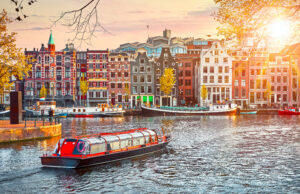

This website is still under construction. We aim at launching our first courses in Amsterdam in 2026.
Emiel van Rossum
Introduction
This 5-day course provides a practical introduction to Fire Safety Engineering. Participants will delve into the fundamental physics of fire, exploring topics such as combustion processes, pyrolysis, heat transfer mechanisms and smoke spread dynamics. Through interactive lectures and practical examples, attendees will gain a solid understanding of how fires ignite, develop, and can be effectively managed.
The course also introduces essential modeling techniques like Zone Models and Computational Fluid Dynamics (CFD), which are crucial tools for simulating fire behavior and designing safety systems. Participants will learn how to apply these models to real-world scenarios, enhancing their ability to predict and mitigate fire risks.
The course also includes topics like evacuation strategies, human behavior in fire situations, and the design of safety systems that prioritize occupant safety.

The book “Introduction to Fire Safety Engineering” is included in the course.
Who Should Attend
The target audience includes fire safety consultants, prevention staff of fire departments or safety regions, fire investigators, building and housing inspectors, and permit issuers.
Ideal participants are professionals with experience in fire safety regulations who wish to transition from a regulatory approach to a more performance-based and scientific methodology.
Participants should have a foundational understanding of mathematics and physics equivalent to higher secondary education levels—such as A-levels in the UK, Abitur in Germany, or the Baccalauréat in France. This knowledge will enable them to grasp the scientific concepts covered in the course.
Please note that individuals with a bachelor’s degree or higher in fire safety engineering may find the course content too basic for their advanced level of expertise.
This course is set at the undergraduate level, offering foundational content and concepts suitable for this academic level.
Who Should Attend
The target audience includes fire safety consultants, prevention staff of fire departments or safety regions, fire investigators, building and housing inspectors, and the authority having jurisdiction (AHJ).
Ideal participants are professionals with experience in fire safety regulations who wish to transition from a regulatory approach to a more performance-based and scientific methodology, as well as individuals who simply want to learn more about the performance-based approach.
Participants should have a foundational understanding of mathematics and physics equivalent to higher secondary education levels—such as A-levels in the UK, Abitur in Germany, or the Baccalauréat in France. This knowledge will enable them to grasp the scientific concepts covered in the course.
Please note that individuals with a bachelor’s degree or higher in fire safety engineering may find the course content too basic for their advanced level of expertise.
This course is set at the undergraduate level, offering foundational content and concepts suitable for this academic level.
Course Content
This 5-day introductory course includes a combination of theory lessons and assignments. The application assignments can be carried out individually or in groups. This way, you learn to translate theory into practice.
Explanation of icons:
This course combines both theoretical understanding and practical application. Throughout the course, we will engage in a series of small exercises to apply the concepts learned, such as performing calculations related to heat transfer and understanding the interplay between energy, heat release rate, and time. These hands-on tasks are designed to reinforce the theory and help build practical skills in fire safety engineering.
Allocation of time across the following topics:
Optional evening program
 On Thursday evening, we invite you to join our exclusive optional evening program, which offers a unique perspective on the historic heart of Amsterdam. You’ll embark on a guided boat tour along the city’s UNESCO-listed canal belt, where you can admire the beautifully preserved 17th-century gabled houses, charming bridges, and vibrant waterfront life. Throughout the cruise, a local guide will provide insights into Amsterdam’s rich history, architectural heritage, and cultural highlights.
On Thursday evening, we invite you to join our exclusive optional evening program, which offers a unique perspective on the historic heart of Amsterdam. You’ll embark on a guided boat tour along the city’s UNESCO-listed canal belt, where you can admire the beautifully preserved 17th-century gabled houses, charming bridges, and vibrant waterfront life. Throughout the cruise, a local guide will provide insights into Amsterdam’s rich history, architectural heritage, and cultural highlights.
During the tour, we will enjoy a dinner featuring a selection of quality dishes. We are attentive to all dietary requirements and will do our utmost to accommodate specific preferences or restrictions. The cost for the evening program is €195 per person, (excluding 21% Tax).
Please note that the program will only proceed if enough participants register. You will be asked to indicate your interest in this optional add-on during the registration process.
Why Choose This Course
Experience the benefits that make our course the ideal choice for advancing your fire safety expertise:



